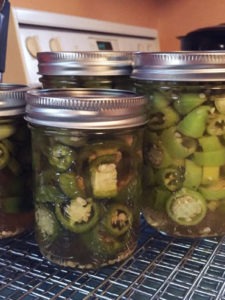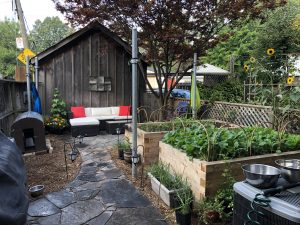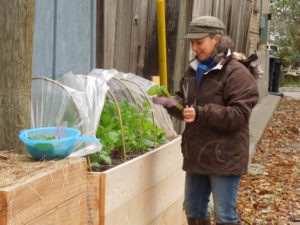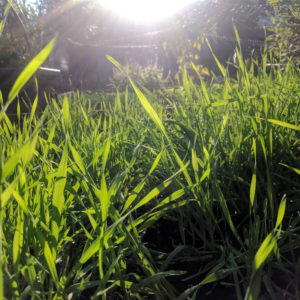Goodnight Gardens – Feed the Soil that Feeds You
Autumn is a bittersweet time of year. The days are getting noticeably shorter yet garden-weary plant-lovers can now look forward to a winter rest. But before that can happen there is much to be done before putting your gardens to bed and putting your feet up with a hot toddy.
The time has come to harvest and preserve the last of your bounty, bring your tender perennials indoors, set up your hoop tunnels or cold frames, plant your garlic, clean your tools and accessories and finally feed and cover your soil.
|
|
|
Preserve the Harvest
As first frost draws nearer, heat loving crops may still be producing but are well past their peak. There are many ways to pickle, freeze, can, dry and store a variety of home-grown veggies and herbs. We like to harvest and ripen the remaining green tomatoes on the window sill and freeze any ripe fruits, skins and all (so much easier than canning) that we can’t use right away. Pickling hot peppers is a quick, easy way to store extra harvests long-term. Bring tender perennial herbs like rosemary and bay indoors, and harvest the last of your basil. Basil can hang to dry, or can be blended with a bit of olive oil and frozen in ice cube trays for later use.
Protect Your Cold Hardy Crops
Now is the time of year to be harvesting and enjoying crops that you planted and sowed in late summer – all those greens, lettuce, radish, cabbage, and bok choi. Cold hardy crops, especially carrots, beets, and kale are getting sweeter as temperatures dip. This is a perfect time to install hoop tunnels or set up cold frames so you can protect those crops from below zero temperatures and extend your harvesting season well into winter.
|
|
|
Cover Cropping
This season we are experimenting with different methods of putting our gardens to bed. We are trying to follow a no-till philosophy, doing our best not to disturb the soil and the many creatures living and working there. We take a cue from the perennial forest that builds its life-rich soil from the top down as leaves fall and decompose thanks to the work of hungry insects and microorganisms. In our own gardens, rather than pulling spent plants out by the roots, we “chop and drop”. Which simply means chopping the plant down at the stem, leaving its roots in the soil and dropping the foliage on the soil as mulch. It’s best to first cut up the healthy plant material with shears or pruners and dispose of diseased or infected plant material in yard waste bags or garbage, depending on the nature of the disease/infection.
Before adding a layer of mulch we replenish the soil with a good quality, organic compost and then cover the soil with the chopped up garden waste mixed with a two inch layer of organic straw. There isn’t usually enough plant material to cover the full expanse of the garden and straw is an inexpensive and carbon rich food source. The compost, mulch and remaining roots provide much needed food for both the fungi and bacteria in the soil. Come spring, your plants will reward you with healthy abundant harvests.
Another great method of feeding your soil is with the use of cover crops. That simply means seeding the soil with living plants like winter rye, peas and oats, or clover. Here we take our inspiration from regenerative, biodynamic, permaculture and organic farmers like Mary-Howell Martens and Klaas Martens who know that the key to thriving ecosystems and a healthy food supply for all living things starts with healthy and biodiverse soil.
|
|
|
|
Nature does not like bare soil. For proof, just see how quickly bare soil becomes covered in “weeds”. It’s better to cover the soil with crops that will build biomass, prevent erosion, increase nutrient and water holding capacity, provide food for insects and microorganisms, sequester carbon, capture atmospheric nitrogen, and out compete invasive weeds. And that’s just for starters.
Different cover crops get seeded at different times of the year and perform different soil building duties. Powerful crops like Diakon radish can be employed to break up hard pan soils. In spring we can seed red and white clovers as a living mulch around a variety of plants. Both varieties have the ability to capture nitrogen from the air, something most other crops can’t do. The clover then delivers the nitrogen to the organisms in the soil who then convert it into a form of nitrogen that the plants can use. How magical is that?! You can chop and drop the clover a few times throughout the season, to prevent it from flowering, spreading seeds and getting too out of hand. However it’s nice to allow a few flowers to develop as it’s a great food source for our pollinating friends, the bees.
In late summer and early fall we can seed winter rye which has the benefit of being able to germinate at low temperatures and grow fairly quickly. That means we can keep our tomatoes, and other crops in the ground longer so the last of their fruits can develop. The winter rye will come up as the last of the tomatoes and other crops are winding down. When a hard frost hits, the rye will die and can be left to decompose over the winter. We’re going to try topping up the rye with shredded fallen leaves or straw mulch. The whole biomass gets lightly worked into the soil in the spring.
Now all our garden plans include cover crops in our regular crop rotations. And yours can too.
Many quality seed suppliers carry a variety of different cover crop seeds and have fabulous web sites and catalogues that can help you choose which variety is right for your particular situation.
Thanks to the ground-breaking work (pun intended!) of soil scientists like Elaine Ingham and organic farmers like Mary-Howell Martens and Klaas Martens, people are now realizing that, to feed ourselves with nature’s bounty, we need first to feed the soil.
What’s Next
- Plant Garlic – It will soon be time to plant garlic, usually soon after Thanksgiving.
- Microgreens – For those of you who want fresh greens all through the winter, consider growing your own micro greens indoors on a windowsill or under lights. It’s easy, cost effective, delicious, and highly nutritious!
Posted in
Tags
Comment
Comments are closed.







[…] we incorporate cover crops such as clover, oats, peas, and rye into our soil, we ‘disk’ or chop it in and leave the dead […]